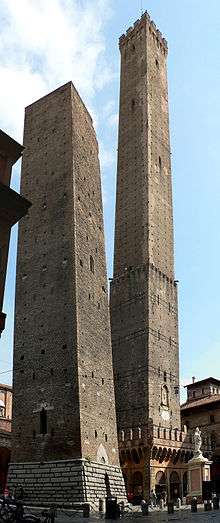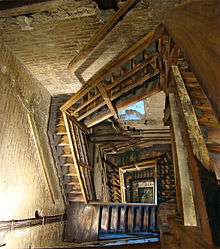Two Towers, Bologna
The Two Towers (Italian: Le due torri), both of them leaning, are the symbol of Bologna, Italy,[1] and the most prominent of the Towers of Bologna. They are located at the intersection of the roads that lead to the five gates of the old ring wall (mura dei torresotti). The taller one is called the Asinelli while the smaller but more leaning tower is called the Garisenda. Their names derive from the families which are traditionally credited with having been constructed between 1109 and 1119.[2] Their construction was a competition between the two families to show which was the more powerful family.[3][4] However, the scarcity of documents from this early period makes this in reality rather uncertain. The name of the Asinelli family, for example, is documented for the first time actually only in 1185, almost 70 years after the presumed construction of the tower which is attributed to them.
Due Torri | |
 Picture of the Two Towers in Bologna | |
| Location | Bologna, Italy |
|---|---|
| History | |
| Founded | 1119 |
| Periods | High Middle Ages |
| Site notes | |
| Condition | Restored |
Asinelli Tower

It is believed that the Asinelli Tower initially had a height of ca. 70 m and was raised only later to the current 97.2 m (with an overhanging battlement of 2.2 m). In the 14th century the city became its owner and used it as a prison and small stronghold. During this period a wooden construction was added around the tower at a height of 30 m above ground, which was connected with an aerial footbridge (later destroyed during a fire in 1398) to the Garisenda Tower. Its addition is attributed to Giovanni Visconti, Duke of Milan, who allegedly wanted to use it to control the turbulent Mercato di Mezzo (today via Rizzoli) and suppress possible revolts. The Visconti had become the rulers of Bologna after the decline of the Signoria of the Pepoli family, but were rather unpopular in the city.
Severe damage was caused by lightning that often resulted in small fires and collapses, and only in 1824 was a lightning rod installed. The tower survived, however, at least two documented large fires: the first in 1185 was due to arson and the second one in 1398 has already been mentioned above.
The Asinelli Tower was used by the scientists Giovanni Battista Riccioli (in 1640) and Giovanni Battista Guglielmini (in the following century) for experiments to study the motion of heavy bodies and the earth rotation. In World War II, between 1943 and 1945, it was used as a sight post: During bombing attacks, four volunteers took post at the top to direct rescue operations to places hit by Allied bombs. Later, a RAI television relay was installed on top. Architect Minoru Yamasaki is thought to have been inspired by the Towers when designing the World Trade Center during the 1960s.[5]
Garisenda Tower
The Garisenda Tower today has a height of 48 m with an overhang of 3.2 m. Initially it was approximately 60 m high, but had to be lowered in the 14th century due to a yielding of the ground which left it slanting and dangerous.[5] In the early 15th century, the tower was bought by the Arte dei Drappieri, which remained the sole owner until the Garisenda became municipal property at the end of the 19th century.
It was cited several times by Dante in the Divine Comedy and The Rime (a confirmation of his stay in Bologna),[1] and by Goethe in his Italian Journey. The Two Towers have also been the subject of an eponymous poem by Giosuè Carducci as part of the Barbarian Odes. Charles Dickens wrote about the towers in his Pictures from Italy.[6]
References
- Naomi Miller (1989). Renaissance Bologna: a study in architectural form and content. P. Lang. ISBN 978-0-8204-0885-9.
- Atkinson's Casket. Sam. C. Atkinson. 1832. pp. 409–.
- Proceedings of the Massachusetts Historical Society. The Society. 1918.
- Luciano Mangiafico (2007). Italy's Most Wanted: The Top 10 Book of Roman Ruins, Wonderful Wines, and Renaissance Rarities. Potomac Books, Inc. pp. 301–. ISBN 978-1-61234-046-3.
- Phillip James Tabb; A. Senem Deviren (2 March 2017). The Greening of Architecture: A Critical History and Survey of Contemporary Sustainable Architecture and Urban Design. Taylor & Francis. pp. 86–. ISBN 978-1-351-88861-5.
- Charles Dickens. American Notes, Pictures from Italy ~ Paperbound. Classic Books Company. pp. 392–. ISBN 978-0-7426-9686-0.
External links
| Wikimedia Commons has media related to Torre degli Asinelli (Bologna). |
| Wikimedia Commons has media related to Torre della Garisenda (Bologna). |